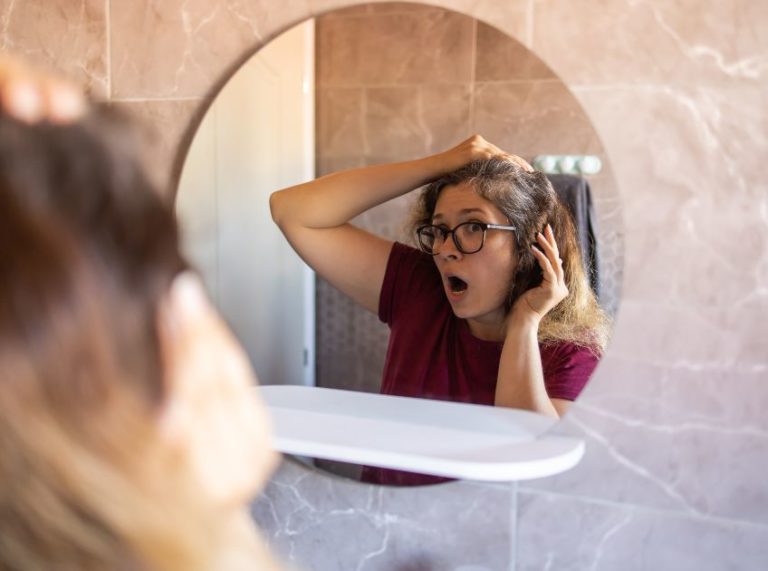
Important: This article is for informational purposes only. Please read our full disclaimer for more details.
People’s choices in styling their eyebrows vary. While some like them thick, others prefer them to be thin. The same goes for unibrows.
Unibrow eyebrows, also called monobrow, refers to eyebrows that are long and connect together. While some people take pride in their unibrow and style them, others want to get rid of them. If you are the latter one, we have mentioned how to get rid of unibrows in easy ways, along with their risks and safety measures.
Keep reading!
Article Contains
How To Get Rid Of Unibrow At Home
Plucking Hair
Plucking is one of the common practices to bring proper shape to the eyebrows. The best thing about it is plucking can be done at home using a tweezer and requires no practice. However, it is a time-consuming process because only one hair is removed at a time.
If you want to get rid of unibrow through plucking, here’s what you need to keep in mind:
- Always pluck one hair at a time.
- Stretch the skin gently from where you need to pluck the hair.
- Grip the bottom of the hair and gently pull it out in one swift motion.
- Pull hair in the direction of its growth.
- Apply lotion over the area once the desired hairs are plucked.
Plucking is one of the most affordable procedures for removing unwanted hair from the eyebrows. Even though it may cause slight pain, the results last for 10-12 days.
Using Depilatory Cream
Depilatory creams consist of strong chemicals that melt the hair. It is a simple and painless process to remove unibrows. All you need is to apply the cream over the desired area between the brows and rinse it off, as directed.
The result of this process may last for two weeks. However, before using any depilatory cream, ensure taking a patch test to prevent the chances of skin irritation. You can also look out for creams that are meant for your skin type and use them carefree.
Waxing
Another effective method to remove unibrow is waxing the area. Apply wax, followed by a strip of cloth, and remove it quickly to get rid of unwanted hair. Alternatively, you can also use waxing strips to get rid of unibrows.
If your skin is hypersensitive, wounded, has warts, or is sunburned, try to avoid using wax for hair removal. Waxing may feel like a painful process, but its results last very long. It is better to visit a salon for waxing than try it at home, especially if you are a beginner.
Shaving
Often, people shave to remove unwanted hair from legs, pubic area, underarms, etc.; however, you can also shave unibrow. Here’s what you need to keep in mind while shaving the unibrows:
- Use an eyebrow razor to accomplish the process
- Prepare the skin by applying shaving gel or cream
- Shave in the direction of hair growth to prevent ingrown hairs
- Apply soothing lotion after shaving for quick healing
You can use either a traditional razor for eyebrows or an electric razor. Even though it’s a simple process, the result of shaving doesn’t last for long. At the same time, it doesn’t allow you to choose which hair you want to remove, unlike in plucking.
Threading
Threading is one of the ancient practices of unwanted hair removal. In the process, a threading tool is required that takes hair in the loop and plucks it out. People who have expertise in threading should be employed to remove the unwanted hair, or else the shape of the eyebrow may be disturbed.
The results of threading are also long-lasting, like that of plucking and waxing. Usually, it is a safe procedure but may cause slight skin irritation. Applying soothing lotion after threading is advised.
Removing Unibrows Through Treatment
While all the aforementioned methods are temporary and require repetition after a few days or weeks, certain medical treatments can remove the unibrows permanently.
People looking for a permanent solution for their unibrow can visit a dermatologist can ask for one of the following procedures-
- Electrolysis– One should take this procedure only from a dermatologist or licensed electrologist due to its complexity (1). In it, the provider uses fine needles that generate strong electric currents to destroy hair roots.
After a few days, the treated hair falls down and never grows back. Even though it’s a permanent solution to get rid of unibrows (2), you need to take multiple time-consuming sessions to get the desired result. The chances of scarring and infection are there. Also, electrolysis is expensive compared to traditional methods.
- Laser hair removal– Another technique that gives a permanent solution is laser hair removal, which needs to be performed only by a professional technician (3). In the process, laser light beams are directed to the unibrows, making the hair dead from the roots. It ensures no further growth of hair.
Usually, the results are permanent, and follow-up sessions are needed to achieve fruitful results (4). Post-treatment, some people develop scar and rashes that fades and resolve on their own. There can be other side effects, too.
Conclusion
Getting rid of unibrows is a personal choice. While sometimes it comes in fashion and people love to carry and flaunt them, other times it goes out of fashion and people start searching how to get rid of unibrows. In some cultures, unibrows in men are considered a part of their masculinity. Such men are believed to be more fertile and powerful.
When you are thinking about removing unwanted hair from your brows, make sure you pick the right method. It depends upon your skin type, pain endurance, and whether you want a temporary or permanent solution.
Related Articles


















